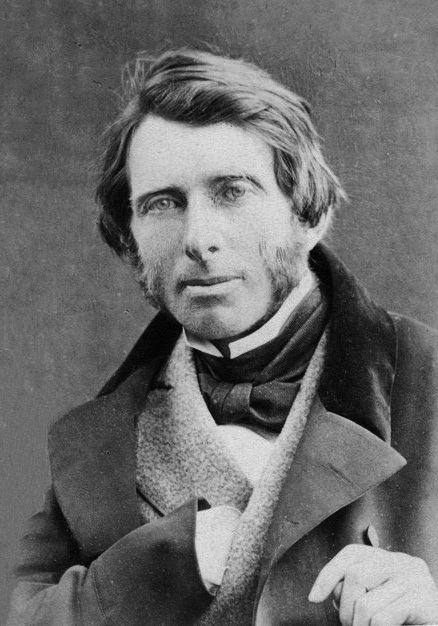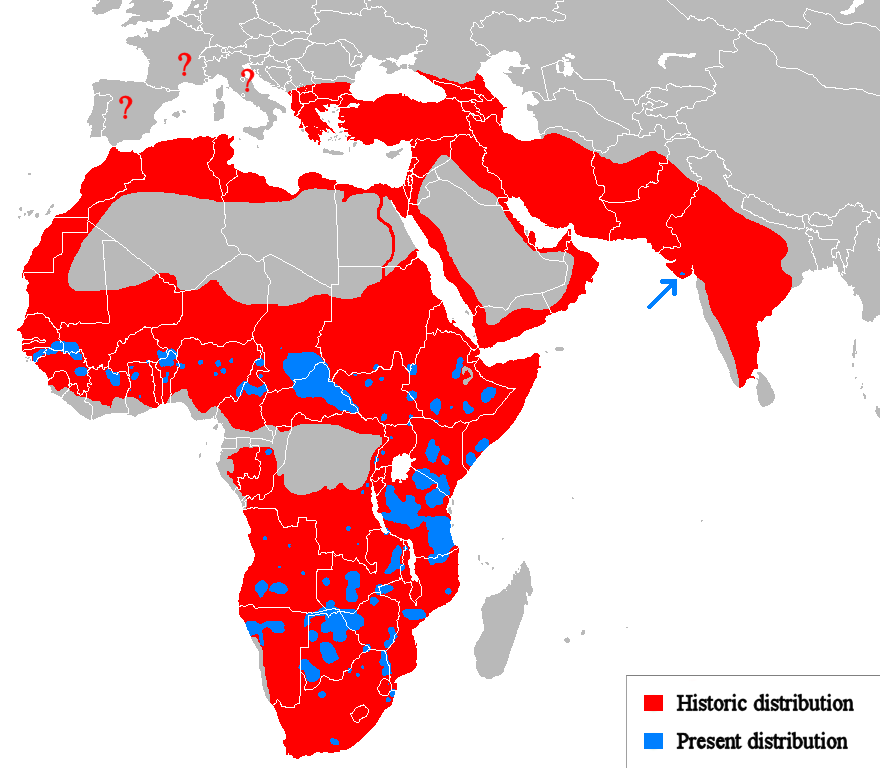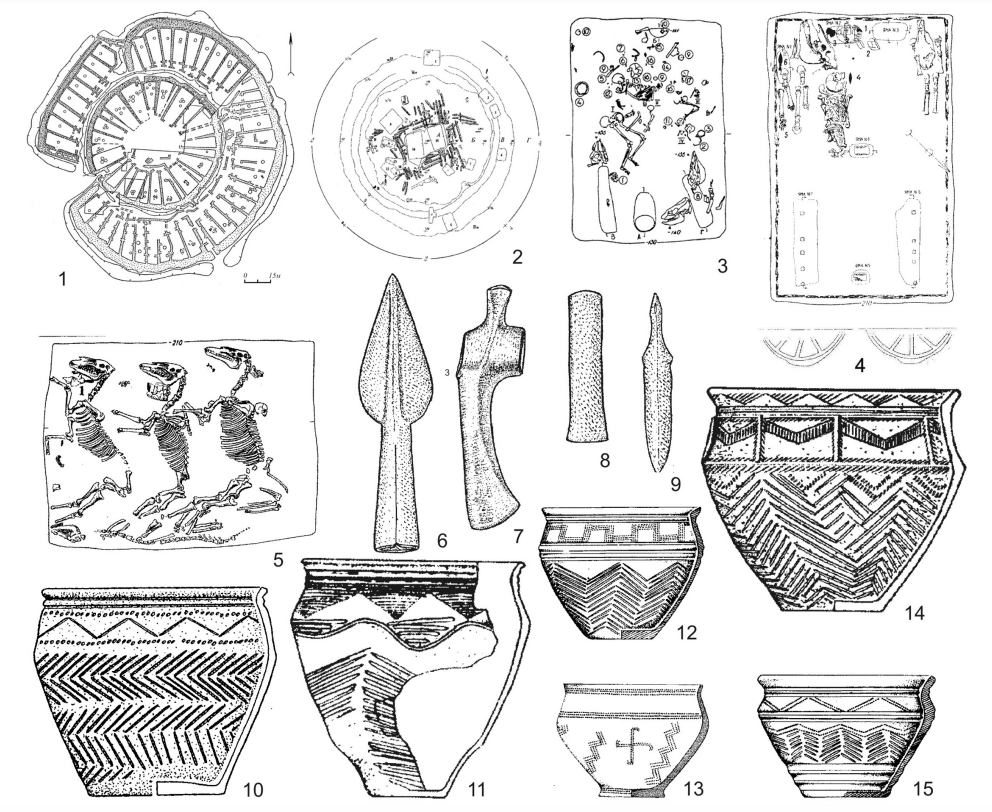|
Veroli Casket
The Veroli Casket is a Middle Byzantine casket, probably made in Constantinople (now Istanbul) in the late 10th or early 11th century, and now in Room 8 of the Victoria and Albert Museum, London. It is thought to have been made for a person close to the Imperial Court of Constantinople, the capital of the Byzantine Empire, and may have been used to hold scent bottles or jewellery. It was later in the Cathedral Treasury at Veroli, south east of Rome, until 1861. Description The casket's dimensions are: height: 11.5 cm, length: 40.3 cm, width: 15.5-16 cm, and weight: 1.72 kg. It is made of carved ivory and bone panels showing scenes from classical mythology. On the lid is a depiction of the Rape of Europa. On the front are scenes from the stories of Bellerophon and Iphigenia. On the back is part of a dionysiac procession, with two figures identified as Mars, god of war (the Greek Ares), and Venus, goddess of love (the Greek Aphrodite). The ends bear scenes ... [...More Info...] [...Related Items...] OR: [Wikipedia] [Google] [Baidu] |
Constantinople
Constantinople (#Names of Constantinople, see other names) was a historical city located on the Bosporus that served as the capital of the Roman Empire, Roman, Byzantine Empire, Byzantine, Latin Empire, Latin, and Ottoman Empire, Ottoman empires between its consecration in 330 until 1930, when it was renamed to Istanbul. Initially as New Rome, Constantinople was founded in 324 during the reign of Constantine the Great on the site of the existing settlement of Byzantium, and shortly thereafter in 330 became the capital of the Roman Empire. Following the collapse of the Western Roman Empire in the late 5th century, Constantinople remained the capital of the Eastern Roman Empire (also known as the Byzantine Empire; 330–1204 and 1261–1453), the Latin Empire (1204–1261), and the Ottoman Empire (1453–1922). Following the Turkish War of Independence, the Turkish capital then moved to Ankara. Although the city had been known as Istanbul since 1453, it was officially renamed as Is ... [...More Info...] [...Related Items...] OR: [Wikipedia] [Google] [Baidu] |
Dionysis
In ancient Greek religion and Greek mythology, myth, Dionysus (; ) is the god of wine-making, orchards and fruit, vegetation, fertility, festivity, insanity, ritual madness, religious ecstasy, and theatre. He was also known as Bacchus ( or ; ) by the Greeks (a name later adopted by the Ancient Rome, Romans) for a frenzy he is said to induce called ''baccheia''. His wine, music, and ecstatic dance were considered to free his followers from self-conscious fear and care, and subvert the oppressive restraints of the powerful. His ''thyrsus'', a fennel-stem sceptre, sometimes wound with ivy and dripping with honey, is both a beneficent wand and a weapon used to destroy those who oppose his Cult of Dionysus, cult and the freedoms he represents. Those who partake of his mysteries are believed to become possessed and empowered by the god himself. His origins are uncertain, and his cults took many forms; some are described by ancient sources as Thrace, Thracian, others as Greek. In O ... [...More Info...] [...Related Items...] OR: [Wikipedia] [Google] [Baidu] |
Rosette (design)
A rosette is a round, stylized flower design. Origin The rosette derives from the natural shape of the botanical rosette, formed by leaves radiating out from the stem of a plant and visible even after the flowers have withered. History The rosette design is used extensively in sculptural objects from antiquity, appearing in Mesopotamia, and in funeral steles' decoration in Ancient Greece. The rosette was another important symbol of Ishtar which had originally belonged to Inanna along with the Star of Ishtar. It was adopted later in Romaneseque and Renaissance architecture, and also common in the art of Central Asia, spreading as far as India where it is used as a decorative motif in Greco-Buddhist art. Ancient origins One of the earliest appearances of the rosette in ancient art is in early fourth millennium BC Egypt. Another early Mediterranean occurrence of the rosette design derives from Minoan Crete; Among other places, the design appears on the Phaistos Disc, r ... [...More Info...] [...Related Items...] OR: [Wikipedia] [Google] [Baidu] |
Ghiberti
Lorenzo Ghiberti (, , ; 1378 – 1 December 1455), born Lorenzo di Bartolo, was an Italian Renaissance sculptor from Florence, a key figure in the Early Renaissance, best known as the creator of two sets of bronze doors of the Florence Baptistery, the later one called by Michelangelo the ''Gates of Paradise''. Trained as a goldsmith and sculptor, he established an important workshop for sculpture in metal. His book of ''Commentarii'' contains important writing on art, as well as what may be the earliest surviving autobiography by any artist. Ghiberti's career was dominated by his two successive commissions for pairs of bronze doors to the Florence Baptistery (Battistero di San Giovanni). They are recognized as a major masterpiece of the Early Renaissance, and were famous and influential from their unveiling. Early life Ghiberti was born in 1378 in Pelago, a comune 20 km from Florence. It is said that Lorenzo was the son of Cione di Ser Buonaccorso Ghiberti and Fiore Ghibe ... [...More Info...] [...Related Items...] OR: [Wikipedia] [Google] [Baidu] |
History Of Nudity
The history of nudity involves social attitudes to nakedness of the human body in different cultures in history. The use of clothing to cover the body is one of the changes that mark the end of the Neolithic, and the beginning of civilizations. Nudity (or near-complete nudity) has traditionally been the social norm for both men and women in hunter-gatherer cultures in warm climates, and it is still common among many indigenous peoples. The need to cover the body is associated with human migration out of the tropics into climates where clothes were needed as protection from sun, heat, and dust in the Middle East; or from cold and rain in Europe and Asia. The first use of animal skins and cloth may have been as adornment, along with body modification, body painting, and jewelry, invented first for other purposes, such as magic, decoration, cult, or prestige. The skills used in their making were later found to be practical as well. In modern societies, complete nudity in public bec ... [...More Info...] [...Related Items...] OR: [Wikipedia] [Google] [Baidu] |
Sir Kenneth Clark
Kenneth Mackenzie Clark, Baron Clark (13 July 1903 – 21 May 1983) was a British art historian, museum director and broadcaster. His expertise covered a wide range of artists and periods, but he is particularly associated with Italian Renaissance art, most of all that of Leonardo da Vinci. After running two art galleries in the 1930s and 1940s, he came to wider public notice on television, presenting a succession of programmes on the arts from the 1950s to the 1970s, the largest and best known being the ''Civilisation'' series in 1969. The son of rich parents, Clark was introduced to the arts at an early age. Among his early influences were the writings of John Ruskin, which instilled in him the belief that everyone should have access to great art. After coming under the influence of the art experts Bernard Berenson and Roger Fry, Clark was appointed director of the Ashmolean Museum in Oxford aged twenty-seven, and three years later he was put in charge of Britain's National G ... [...More Info...] [...Related Items...] OR: [Wikipedia] [Google] [Baidu] |
Ancient Roman Religion
Religion in ancient Rome consisted of varying imperial and provincial religious practices, which were followed both by the Roman people, people of Rome as well as those who were brought under its rule. The Romans thought of themselves as highly religious, and attributed their success as a world power to their collective piety () in maintaining Pax deorum, good relations with the gods. Their Polytheism, polytheistic religion is known for having honoured List of Roman deities, many deities. The presence of Magna Graecia, Greeks on the Italian peninsula from the beginning of the historical period influenced Culture of ancient Rome, Roman culture, introducing some religious practices that became fundamental, such as the of Apollo. The Romans looked for common ground between their major gods and those of the Greeks (), adapting Greek mythology, Greek myths and iconography for Latin literature and Roman art, as the Etruscans had. Etruscan religion was also a major influence, partic ... [...More Info...] [...Related Items...] OR: [Wikipedia] [Google] [Baidu] |
Christianization
Christianization (or Christianisation) is a term for the specific type of change that occurs when someone or something has been or is being converted to Christianity. Christianization has, for the most part, spread through missions by individual conversions, but has also, in some instances, been the result of violence by individuals and groups such as governments and militaries. Christianization is also the term used to designate the conversion of previously non-Christian practices, spaces and places to Christian uses and names. In a third manner, the term has been used to describe the changes that naturally emerge in a nation when sufficient numbers of individuals convert, or when secular leaders require those changes. Christianization of a nation is an ongoing process. It began in the Roman Empire when the early individual followers of Jesus became itinerant preachers in response to the command recorded in Matthew 28:19 (sometimes called the Great Commission) to go to all the ... [...More Info...] [...Related Items...] OR: [Wikipedia] [Google] [Baidu] |
Seahorse
A seahorse (also written ''sea-horse'' and ''sea horse'') is any of 46 species of small marine Osteichthyes, bony fish in the genus ''Hippocampus''. The genus name comes from the Ancient Greek (), itself from () meaning "horse" and () meaning "sea monster" or "sea animal". Having a head and neck suggestive of a horse, seahorses also feature segmented bony armour, an upright posture and a curled prehensile tail. Along with the pipefishes and seadragons (''Phycodurus'' and ''Phyllopteryx'') they form the family Syngnathidae. Evolution and fossil record Anatomical evidence, supported by molecular, physical, and genetic evidence, demonstrates that seahorses are highly modified pipefish. The fossil record of seahorses, however, is very sparse. The best known and best studied fossils are specimens of ''Hippocampus guttulatus'' (though literature more commonly refers to them under the synonym of ''H. ramulosus''), from the Marecchia River formation of Rimini Province, Italy, ... [...More Info...] [...Related Items...] OR: [Wikipedia] [Google] [Baidu] |
Nymph
A nymph (; ; sometimes spelled nymphe) is a minor female nature deity in ancient Greek folklore. Distinct from other Greek goddesses, nymphs are generally regarded as personifications of nature; they are typically tied to a specific place, landform, or tree, and are usually depicted as Virginity, maidens. Because of their association with springs, they were often seen as having healing properties; other divine powers of the nymphs included divination and shapeshifting. In spite of their divine nature, they were not immortality, immortal. Nymphs are divided into various Nymph#List, broad subgroups based on their habitat, such as the Meliae (ash tree nymphs), the Dryads (oak tree nymphs), the Alseids (Grove (nature), grove nymphs), the Naiads (Spring (hydrology), spring nymphs), the Nereids (sea nymphs), the Oceanids (ocean nymphs), and the Oreads (mountain nymphs). Other nymphs included the Hesperides (evening nymphs), the Hyades (mythology), Hyades (rain nymphs), and the Pleiade ... [...More Info...] [...Related Items...] OR: [Wikipedia] [Google] [Baidu] |
Panthera
''Panthera'' is a genus within the family (biology), family Felidae, and one of two extant genera in the subfamily Pantherinae. It contains the largest living members of the cat family. There are five living species: the jaguar, leopard, lion, snow leopard and tiger. Numerous extinct species are also named, including the Panthera spelaea, cave lion and American lion. Etymology The word derives from Classical Latin , itself from the Ancient Greek (). Characteristics In ''Panthera'' species, the dorsal profile of the skull is flattish or evenly convex. The frontal interOrbit (anatomy), orbital area is not noticeably elevated, and the area behind the elevation is less steeply sloped. The basic Cranial cavity, cranial axis is nearly horizontal. The inner chamber of the Auditory bulla, bullae is large, the outer small. The partition between them is close to the external auditory meatus. The convexly rounded chin is sloping. All ''Panthera'' species have an incompletely ossified h ... [...More Info...] [...Related Items...] OR: [Wikipedia] [Google] [Baidu] |
Chariot
A chariot is a type of vehicle similar to a cart, driven by a charioteer, usually using horses to provide rapid Propulsion, motive power. The oldest known chariots have been found in burials of the Sintashta culture in modern-day Chelyabinsk Oblast, Russia, dated to c. 1950–1880 BC and are depicted on cylinder seals from Central Anatolia Region, Central Anatolia in Kültepe dated to c. 1900 BC. The critical invention that allowed the construction of light, horse-drawn chariots was the spoked wheel. The chariot was a fast, light, open, two-wheeled conveyance drawn by two or more Equidae, equids (usually horses) that were hitched side by side, and was little more than a floor with a waist-high guard at the front and sides. It was initially used for ancient warfare during the Bronze Age, Bronze and Iron Age, Iron Ages, but after its military capabilities had been superseded by Light cavalry, light and Heavy cavalry, heavy cavalries, chariots continued to be used for travel and t ... [...More Info...] [...Related Items...] OR: [Wikipedia] [Google] [Baidu] |










